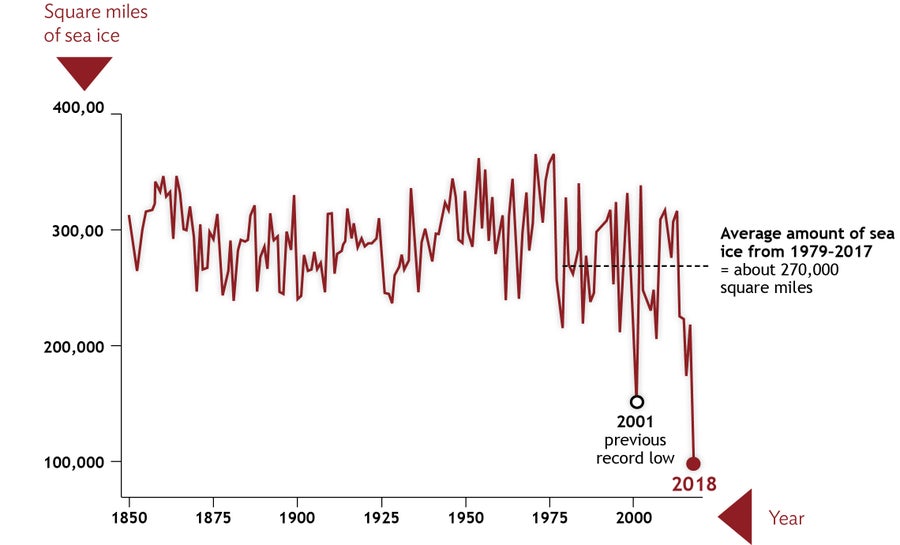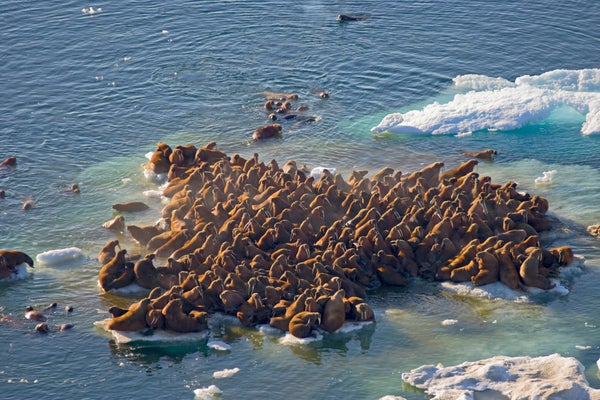April should be prime walrus hunting season for the native villages that dot Alaska’s remote western coast. In years past the winter sea ice where the animals rest would still be abundant, providing prime targets for subsistence hunters. But this year sea-ice coverage as of late April was more like what would be expected for mid-June, well into the melt season. These conditions are the continuation of a winter-long scarcity of sea ice in the Bering Sea—a decline so stark it has stunned researchers who have spent years watching Arctic sea ice dwindle due to climate change.
Winter sea ice cover in the Bering Sea did not just hit a record low in 2018; it was half that of the previous lowest winter on record (2001), says John Walsh, chief scientist of the International Arctic Research Center at the University of Alaska Fairbanks. “There’s never ever been anything remotely like this for sea ice” in the Bering Sea going back more than 160 years, says Rick Thoman, an Alaska-based climatologist with the National Oceanic and Atmospheric Administration.

The record low February sea-ice extent in the Bering Sea, off the coast of Alaska, compared with the 168-year historic record. Credit: Zachary Labe, University of California-Irvine and Heather McFarland, University of Alaska
On supporting science journalism
If you're enjoying this article, consider supporting our award-winning journalism by subscribing. By purchasing a subscription you are helping to ensure the future of impactful stories about the discoveries and ideas shaping our world today.
A confluence of conditions—including warm air and ocean temperatures, along with persistent storms—set the stage for this dramatic downturn in a region that to date has not been one of the main contributors to the overall reduction of Arctic sea ice. Whereas a degree of random weather variability teed up this remarkable winter, the background warming of the Arctic is what provides the “extra kick” to reach such unheard-of extremes, Walsh says.
Sea ice expands outward from the central Arctic Ocean each autumn as the sun dips low in the sky and temperatures drop. In the Chukchi and Bering seas off Alaska, freeze-up used to begin in October. Ice would edge southward and build up throughout the winter until peaking in March when the sun climbs high again, and the ice would then start melting back. But autumn freeze-up in the region has begun steadily later as Arctic temperatures have risen at twice the global rate, fueling a self-perpetuating cycle of ice loss: As it melts it leaves more open water to absorb the sun’s rays in summer, and this further warms the ocean causing more ice to melt, thereby delaying the autumn freeze. In recent years that freeze had moved into November but this year temperatures were so warm the Chukchi Sea still had open ocean in December. “And that,” Walsh says, “hasn’t happened before” in recorded history.
The unusual warmth continued throughout this winter, in part because of an atmospheric pattern that kept warm air and storms periodically sweeping up from the south. One such event in February helped push the monthly temperature over the Bering and Chukchi seas some 18 to 21.5 degrees Fahrenheit (10 to 12 degrees Celsius) above normal. Consequently, the Bering Sea lost half its ice extent at a time when ice should still have been growing. The storms also pushed back against the normal southward flow of ice from the Chukchi Sea into the Bering. Accompanying winds stirred up waves that kept new ice from forming, and broke up what thin ice there was.
Such atmospheric conditions have long been a limiting factor to sea-ice growth in the Bering Sea, Thoman says. But until recently the water there was reliably cold enough in autumn that when winds did blow from the north, sea ice would still spread. The last few years have seen unusually warm ocean waters in the Bering. Research meteorologist Nick Bond and others think this is “a lingering hangover” of a larger marine heat wave—dubbed “The Blob”—that lay off the west coast of the U.S. and Canadian mainland from 2014 to 2016. Bond, who works for NOAA’s Pacific Marine Environmental Laboratory, thinks some of those warm waters followed ocean currents up into the Bering and left a deep reservoir of warmth that impeded ice formation, although he has not yet formally studied this.
The occurrence of these unusual conditions off Alaska this past winter can largely be chalked up to the random weather variations in a chaotic climate system, Bond, Walsh and Thoman all say—but they add that global warming likely amped up the severity of the situation. A study Walsh co-authored in the January Bulletin of the American Meteorological Society found that although The Blob was ushered in by natural variations, without climate change it likely would not have been as intense as it was. And whereas the Bering Sea has had plenty of winters as stormy as this one, the underlying warming trend means such winters can have a much bigger impact on sea-ice formation in today’s climate.
The lack of sea ice is not just hitting walrus hunting hard; throughout the winter and spring, coastal communities have seen substantial flooding and erosion during storms without much of the usual sea ice to act as a buffer. What little there is has been very thin stuff local residents call “junk ice,” Thoman says: “It wasn’t very much better than no ice at all.”
At the end of April the Bering Sea was nearly ice-free—four weeks ahead of schedule. With the sun shining on the Arctic again, the open ocean is soaking up heat that could set up another delayed freeze-up again next fall. Because of the role the weather plays, though, “every year is not going to be like this,” Thoman says. “Next year will almost certainly not be this low.” But as temperatures continue to rise, he says, “odds are very strong that we will not go another 160 years before we see something like this” happen again.
